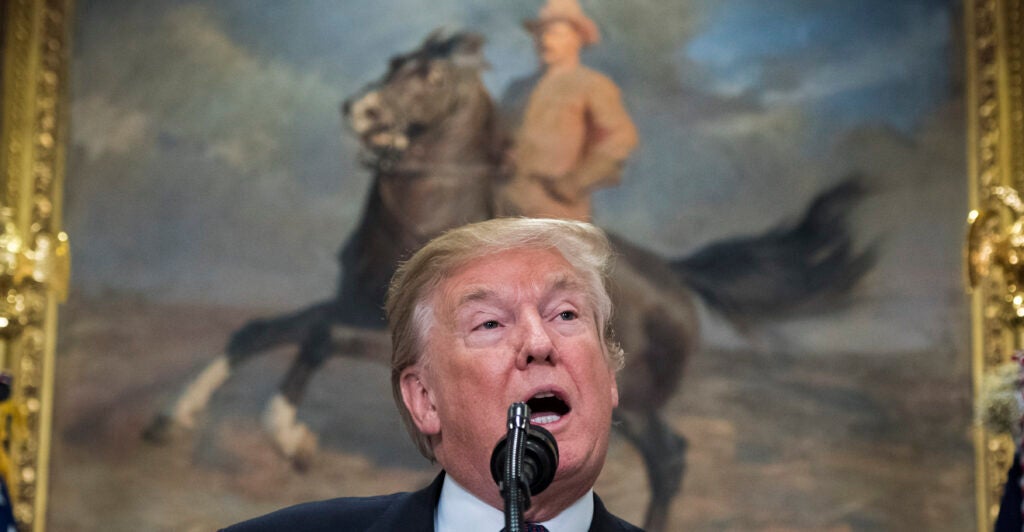The former president with a larger-than-life personality—out of office for four years and with a long list of enemies—campaigns for another term and has a close call with a would-be assassin.
The former president, despite visible bleeding, not only survives the attempt on his life, but exhibits a strong show of strength, rallying his supporters. But the inflammatory rhetoric aimed at the candidate was even blamed for inspiring “vicious minds” to engage in political violence.
It was just after 8 p.m. on Oct. 14, 1912, when former President Teddy Roosevelt—seeking a nonconsecutive third term—was exiting the Gilpatrick Hotel to go deliver a speech at the Milwaukee Auditorium. Then, a former saloonkeeper, John Schrank, pulled a Colt .38 revolver just about five feet away and shot Roosevelt in the chest. The bullet was blunted by a folded-up 50-page speech and a thick eyeglasses case.
While the failed assassination attempt on former President Donald Trump late Saturday afternoon occurred north of Pittsburgh in Butler, Pennsylvania, the 45th president will deliver a speech accepting the Republican presidential nomination this week at the Republican National Convention in Milwaukee—the same city where Roosevelt went on to speak for 84 minutes after taking a bullet.
In the case of Trump, the bullet grazed his ear, and the would-be assassin was fatally shot by Secret Service agents at the scene.
When Roosevelt was shot, his supporters called for killing the shooter. Several leapt on him and landed several punches. Roosevelt said, “Don’t hurt him. Bring him here. I want to see him.”
The attempted assassin was brought face-to-face with his target, and Roosevelt asked Schrank, “What did you do it for?” Schrank didn’t answer, so Roosevelt said, “Oh, what’s the use? Turn him over to the police.”
Roosevelt initially didn’t see any blood and presumed the bullet didn’t penetrate. A nearby doctor told the driver to get the former president to a hospital, but the former president said, “You get me to that speech.”
At the Milwaukee Auditorium, Roosevelt told the stunned audience, who in the absence of TV or social media would hear the news for the first time, “I don’t know whether you fully understand that I have just been shot.”
In a line perhaps comparable to Trump’s pumping his fist to reassure his Pennsylvania audience on Saturday, Roosevelt gained a rousing ovation from the Wisconsin crowd affirming, “It takes more than that to kill a bull moose.”
Earlier in 1912, Roosevelt—a former Republican president, who served from 1901 to 1909—lost his bid for the GOP nomination when he challenged his successor, President William Howard Taft. Roosevelt ran as the candidate of the Progressive Party, which was nicknamed the Bull Moose Party.
The two assassination attempts have many parallels, but many differences as well. Perhaps most evident is that the Roosevelt shooting was at close range and with a revolver. The Trump shooting was at long range with an AR-style rifle.
The nature of the wounds were also different. A bullet fragment was lodged between Roosevelt’s ribs not far from his heart, but doctors determined it was best not to remove it. The bullet on Saturday grazed Trump’s right ear, and left a bloody face. Roosevelt was shot just before his political rally, while Trump was shot during his rally.
After the Trump assassination attempt on Saturday, much of the anti-Trump rhetoric has come to the forefront, as Democrats and many media outlets have claimed that he’s an “existential” threat to democracy, and even compared him to Nazi leader Adolf Hitler.
Political opponents and many newspapers of the era said Roosevelt was a power-hungry traitor to his country for breaking the tradition of serving two terms, according to History.com.
In his Milwaukee speech with a blood-soaked shirt, Roosevelt said: “It is a very natural thing, that weak and vicious minds should be inflamed to acts of violence by the kind of awful mendacity and abuse that have been heaped upon me for the last three months by the papers.”
The assertion was somewhat borne out by Schrank’s diary, which said afterward: “I did not intend to kill the citizen Roosevelt. I intended to kill Theodore Roosevelt, the third termer.”
It was Roosevelt’s final presidential campaign. A former vice president, he had ascended to the presidency after the assassination of President William McKinley. He served out most of what would have been McKinley’s second term, and was elected in his own right in 1904.
Roosevelt lost the 1912 election to Democrat Woodrow Wilson, but his third-party candidacy finished in second place, outpolling incumbent Republican Taft.
